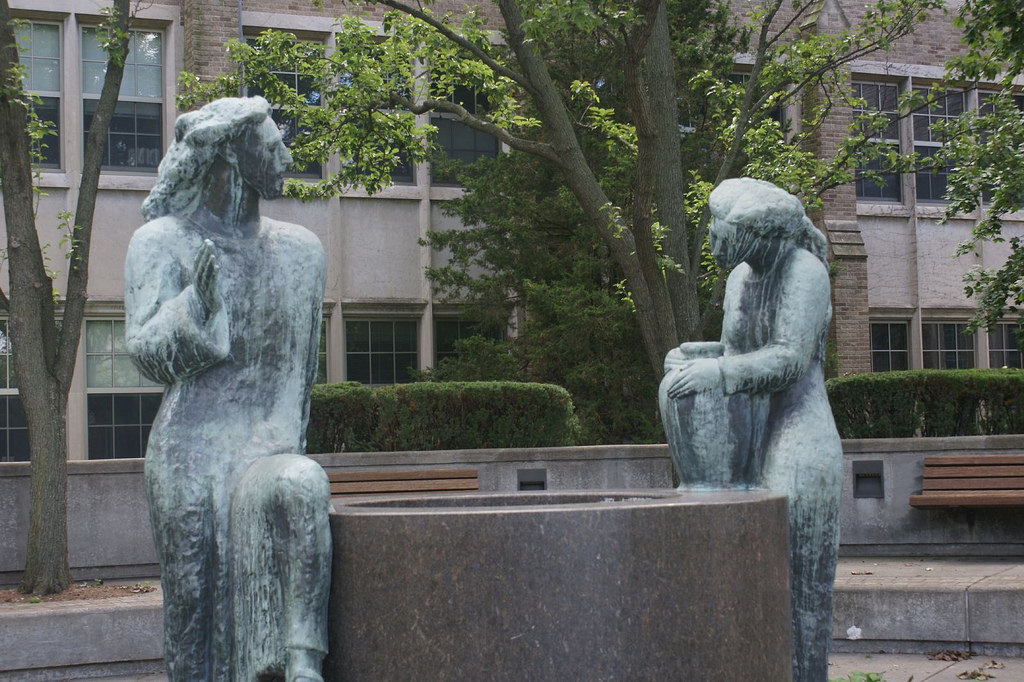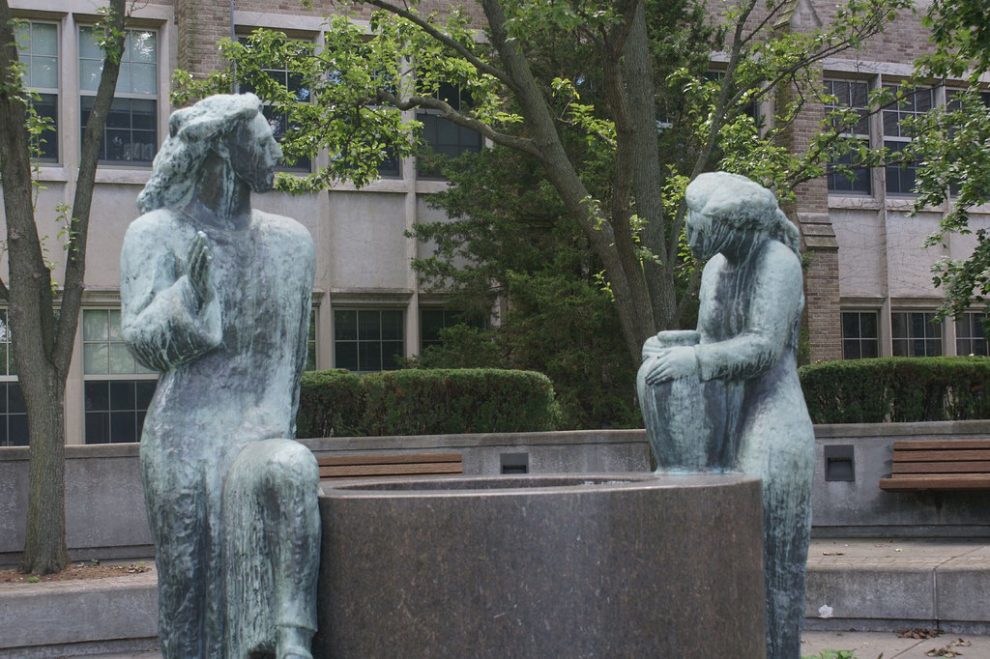When I was little, I was very shy. Once I went with my cousin Kathy to her friend Linda’s house. We knocked and walked into the kitchen, where Linda’s mother said hello to Kathy, and then, peering down at me with piercing eyes, asked, “And who are YOU?” I never answered. I couldn’t. Quaking, I hid behind my cousin.
These days, I hide differently. I have some achievements, a community, and a job title. Now when the question is put to me, I can say “I’m a Dominican sister” or “I’m a retreat director.” Like most of us, I answer in terms of what I do or how I’m related to others.
Human beings have a very hard time naming themselves in terms of being or who they are beyond “I’m human” or “I’m a woman.” But we do need to name ourselves, for doing so is an important part of the process of our human and spiritual growth and of coming to understand who and whose we are. And Lent provides a forum for the quest.
The question of identity is one of the key issues of Lent. We see and hear ourselves in the readings and the rites of Lent and especially in the rites of the catechumenate, the aspiring Christians who come to our doorway. With both delight and puzzlement we ask them who they are and we ask ourselves, “Who are we that these should seek to be a part of us?”
The first thing that should be noted about our question and our answer is the word we. Over and over again, the prayers and scriptures talk about our plurality. “Who are you?” is directed to the community or to individuals as a part of a people. My answer of “a baptized Christian” gives me a human context, a human history, and a human future that is inextricably tied to others and to God. It places me in the line of Israel and in Christianity—the “new Israel”—a communion of saints and sinners who will be granted in the days to come a new heaven and a new earth. My salvation is bound to that of others.
What are the ways we name ourselves in Lent? Ash Wednesday begins it all and calls people to repent in fasting and weeping and mourning, to turn back to the One whose they are. And then, in no uncertain terms, the rite of ashes declares, “You are dust and to dust you shall return.”
The rite, however, doesn’t leave us with that answer only. There is another side, a divine balancing that is reflected in the alternate words for the rite: “Reform your lives and believe the good news.”
The good news? The good news is that we are loved, and God will chase us down to bring us back. Salvation is offered to us through Jesus Christ: salvation for the wonderful and exasperating and confusing mix we are, the seesaw tilting toward “puny worm” (Isaiah 41) and then toward “just a little less than the angels (Psalm 8).
The first Sunday of Lent focuses on the waters and the wasteland. The Genesis reading describes the giving of the rainbow after the terrible destruction of the great flood. On a new day in a cleansed world God promises Noah and his descendants never to destroy the earth. The Letter of Peter uses the flood image to describe what happens in baptism. And Mark’s gospel sends Jesus to dwell in the wilderness to be tempted, to dwell with the wild beasts, and to be ministered to by the angels.
In the images of these scripture passages, we can claim: “We are people of the water.” Born of water and the Spirit, how do we live our name “water people”?
We weep. We stand waist deep in tears, our own tears, the tears of our world, and we wonder when shall this weeping be over. What is the weeping asking of me, and how shall I respond?
We wade. We slosh and struggle in the currents of our lives, the turmoil of our own troubles and trials—but never alone, never without a hand to grasp, for in Christ we are brothers and sisters.
We wash. We seek the purifying of our desires and motives. We come weary and dusty to waters that cleanse and freshen.
We thirst. Our parched spirits, our parched earth yearn for love and peace and justice and the fulfillment of God’s promises. And dripping we stand on dry land, the waters of destruction and chaos behind us, the rainbow’s promise shining in our eyes, and we hear again our call to be water bearers: to be ourselves, fountains of life, springs of hope, geysers of grace in the deserts of apathy and bitterness and despair that spot the landscapes of life in our world.
Scripture gives us a second name: “wilderness people,” people of the wasteland. Like Jesus, there are times when we are called to face ourselves without props, without distractions, to hear our names spoken in the silence, to risk the “wild beasts” of our drivenness, our compulsions, our sins. It is experiencing ourselves barren with nothing to give, a pile of dry bones bereft of energy and hope. It is traveling through the desert of our own inner spaces and facing memories that still fester: wrongs we’ve done, wrongs done to us, grudges that we bear, buried feelings that still have a dark power over us.
It is to look at what we’ve done to our world. It means facing the war and the oppression. We recoil in horror. We want to blot it out, to bury it, to run and hide, to deny our part in it. Yet it is when we come to the wastelands—when sorrow and dismay and fury stir us to grope for the silent God, the hidden God, the deus absconditus—and when we are lost in the roiling darkness that we demand to see God’s face and find ourselves in the grip of the God who is also crying no to evil and forsakenness.
We are powerless; only God can save us. We must open ourselves to the God who weeps in the cries of the prophets and in the tears of Jesus over Jerusalem, the God who aches for us in our pain and moves in us and through us to labor for healing and wholeness. The mystery is that when we come to the depths of suffering, of human depravity and evil, of loneliness and alienation, we discover that the love and mercy of God are deeper than any depths. The brightness of God underlies the dark pit, and the living waters of God run deep in the rock below the desert.
There is a figure who represents the meeting place of the wasteland and the waters: the woman at the well. Her story is told in John’s gospel during the third Sunday of Lent with the rites of the catechumenate. I always picture her as she has been rendered by Ivan Mestrovic in a sculpture at the University of Notre Dame. Larger than life, Jesus perches on the edge of the well. Larger than life, across from him stands the woman: graceful, her unveiled hair falling freely, her body showing a certain caution, the tension of one at the edge of truth—leaning toward it, pulling away from it.

Image: Flickr cc via Paul J Everett
The well is the place of self-knowledge and self-naming, where in the light of her conversation with Jesus she comes to know her own truth. She descends to her depths at that well, expecting wasteland—censure, rejection, another abandonment, more thirst—and instead finds the living waters of acceptance and mercy.
There is a saying of the Hasidic rabbis that every person is given two pockets. One pocket contains the words “I am dust and ashes,” and the other pocket holds the words “For my sake the world was created.” The words are there to be pulled out as needed. We often want to hide in one pocket or the other, fearful of the claims of truth. But the eyes of God, shown to us in the gaze of Jesus, are not piercing and judging and belittling. They take it all in and name and redeem and choose us to get out there and tell the good news: I’m a treasured sinner, a waterhole and a wasteland. I splash, I swim, I drink, I drown and am reborn in the living waters. I wander, I explore, I collapse spent in the wilderness. And there are the wild beasts, who lie down beside me in peace; and there are the angels to minister to me; they are community and in their midst, I hear my name: “Beloved.” And I say God’s name: “Beloved.”
Originally published in the April 1994 issue of U.S. Catholic.
Image: Yaoqi LAI on Unsplash












Add comment